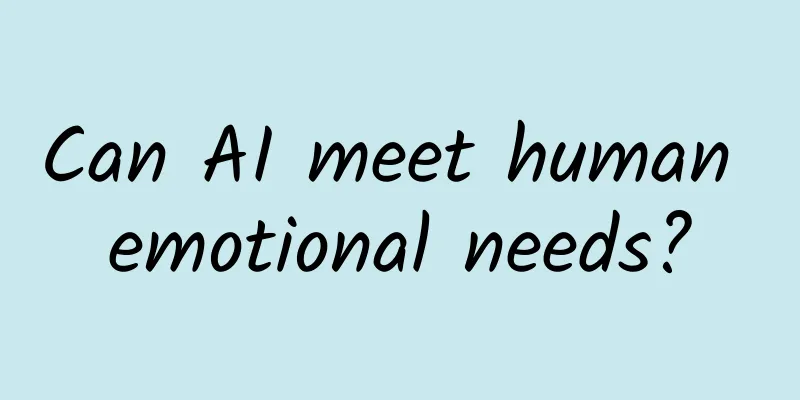Can AI meet human emotional needs?

|
With the continuous advancement of science and technology, the field of artificial intelligence has attracted more and more attention. Many topics about AI have also frequently sparked heated discussions, such as the production of popular AI film and television works, AI majors becoming a highlight of college admissions, and the risks of attempting to use AI to commit crimes are gradually emerging... However, many netizens have raised the question that as AI becomes more and more popular in the future, can it meet the emotional needs of human beings? Perhaps AI is far away from people, so it is difficult to directly imagine whether AI can and how it can meet human emotional needs. Let's change to an analogy. How did pet dogs evolve from wild animals to beings that can meet human emotional needs? Today, let's start with pet dogs and talk to you! 01. How do humans accept dogs to meet certain emotional needs? There are more than 700 million dogs in the world, and almost every 10 people own a dog. According to the three basic members of a family, almost one-third to one-half of the human race has a pet dog as a "quasi-family member" who serves as a family emotional companion. So, how do humans accept dogs to meet their emotional needs? In fact, I have a deep understanding of this aspect. The process of pet dog domestication is actually very similar to the process of AI evolving into a human emotional companion: it is also learning how to enter human life and become an important member of emotional companionship. This process is accompanied by two key processes: demand + learning 02. How to meet one of the human emotional needs - motivation Whether it can satisfy human emotions depends first on whether humans have the need and motivation to domesticate pets and AI. Many people think that dogs entered human life after the civilization era, that is, in the last 10,000 years since the agricultural era. Research has found that the domestication of dogs may have begun in the Paleolithic Age 30,000 years ago. At that time, humans ate raw meat and drank blood, gathered and hunted, and some relatively docile gray wolves chose to have mutual benefits with humans. For example, when food was scarce, humans stored food and gave some to wolves to eat, and in return, wolves provided security and hunting for humans. Humans developed a need to domesticate them. Over the long years, humans continued to intervene in wolf breeding, and eventually turned wolves into more docile and obedient emotional companions - dogs. However, having a need is only the first step. Dogs, as important companion animals of humans, are very different from other domestic animals, and this process is the second important factor: learning. 03. How to meet human emotional needs 2 - learning AI learning and evolution is a necessary part of becoming an emotional companion. I believe that after many people get a dog, there must be an important step: educating the pet dog. Yes, whether it is to teach dogs some rules, such as going to a designated place to defecate, or to teach dogs to communicate with humans, the typical thing is to understand human instructions. Some dogs can even master hundreds or even more human instructions. In this process, the dog's learning is very critical. In fact, after long-term adaptation, dogs have even evolved special biological mechanisms to adapt to humans, which are imprinted in their genes. For example, a previous article published in Scientific Reports pointed out that dogs use facial expressions to communicate with humans. In this study, researchers recorded the interactions between 24 dogs and humans, and summarized and classified the dogs' responses to human actions. The results showed that even if it was a complete stranger, the dogs would show different expressions in response, and if the person was facing the dog, their expressions were richer. In other words, the dogs were trying to use facial expressions to communicate with humans. You know, this is a very advanced skill that does not exist in most animals. Other similar studies have also shown that compared with dogs' close relatives, wolves, dogs have more facial muscles, especially eye muscles, which also makes it easier for them to display a wider variety of expressions and emotions. Because of this, dogs are very successful as companion animals. They have entered hundreds of millions of homes and become important companions of humans. Needs and learning are one of the fundamental factors that make dogs human companion animals, so what about AI? 04. Can AI satisfy human emotional needs like dogs? In fact, from dogs, we can see the possibility of AI meeting emotional needs in the future, that is: needs + learning. Let's look at them one by one. First of all, do we need AI? The answer is yes. There are several main angles to this, and I will try to interpret them. 1. The aging population and declining birthrate are serious problems, and more people are facing the reality of lack of companionship. Aging and declining birthrates have become the two most serious population problems today. Almost every time related news appears, it triggers an uproar and discussion on the Internet. There are many countries in the world with very serious aging populations, and the birth rate in Asia and Europe continues to decline. At the same time as the aging population, the declining birthrate has become another important phenomenon. These will likely exacerbate the negative population growth. Aging and the declining birthrate have led to many elderly people lacking companionship, and their emotional needs are difficult to be fully met. 2. Although traditional views on love and marriage are changing, human beings’ need for emotional and sentimental values remains unchanged. Over the years, with the development of social economy and the popularization of the Internet, the traditional concept of love and marriage seems to be collapsing. Whether it is the gradually declining marriage rate and the rising divorce rate, or the increasingly later age of marriage and childbearing, these all mean that traditional love and marriage are changing. Many people have entered a stage where they don't want to fall in love, or they don't want to have children after getting married. However, humans are social animals and they need to express and communicate emotions. At this time, the need for an interactive object is very important, and AI can also meet this need. 3. AI can do more than just pets In fact, at this time, we still have a problem, that is, the things that companion animals such as dogs cannot do are also the advantages of AI. The simplest one is that dogs cannot communicate directly with humans through language, which is one of the biggest obstacles. If we keep talking to our pet dogs, it is just like playing the piano to them. However, AI can communicate with humans, which is one of its great advantages and can give people a sense of social participation. In addition, it provides 24-hour companionship, is available on call, does not require maintenance, and can meet more advanced interaction needs, such as letting AI make plans or even alarms. It can be said that AI can, in theory, meet human emotional needs. So, if there is a need, what about learning? This is naturally a no-brainer. The biggest advantage of AI is learning. 05. The biggest advantage of AI is learning Dogs have gone through more than 30,000 years of domestication and learning to become what they are today. After all, the emergence and fixation of many traits require everything from epigenetics to gene mutations, plus strong artificial selection from generation to generation. AI does not have these obstacles at all, especially the development of modern technology, which has greatly improved the capabilities of AI. If AI wants to meet human emotional needs, it must first understand the person's emotions, behaviors, habits, etc., which requires huge computing power to support. Every person is unique, and this uniqueness is not only his appearance, but also the long-term development of living habits and personal character. These contents cannot be captured intuitively, but need to be seen, analyzed, and concluded from many details. For example, AI is already relatively mature in collecting and analyzing facial expressions, but the subtle facial expressions of many people are still ever-changing and may not necessarily reflect their true emotions. It could be a slight tremor of their fingers, or a slight pause when their eyes glance away, or even just being silent for a little longer today, or they may have intentionally or unintentionally changed the furnishings of their home. These all reflect subtle changes in human emotions. AI's analysis of these emotional details requires very complex calculations. However, obtaining a large amount of details for calculation is the most basic way for AI to understand a person's emotions, and it can and must rely on powerful computing power. There are already companies researching this aspect. On the road of AI evolving into a companion, this is what we usually say: the more computing power, the more productivity, and the more possibilities in the future. In addition, a person's emotions cannot be confined to the home, and a person cannot be locked in the house forever. We need to travel abroad, go on business trips, travel long distances, go shopping, and travel in countless scenarios, which are the daily lives of ordinary people. In fact, for most people, after adulthood, they may spend less than half of their time at home. At this time, the ubiquitous connection between humans and AI is very necessary. Our emotional needs are always there during our commute, at traffic lights, in supermarkets and squares, so we need this kind of ubiquitous connection with AI at any time and anywhere. On the basis of meeting the above foundations, AI may be the core of emotional needs. To understand emotions, we need AI to understand us and truly be our close friends, which is different from the widely used question-answering robots. What we need is a customized one that truly belongs to us, so machine learning, especially neural networks, is the core, and it is the key to understanding ourselves. Moreover, it is not just about understanding and emotion, there must be interaction. It is not about us talking to the machine all the time like in a tree hole, but a real companionship where we can chat with each other. This also requires artificial intelligence to be more intelligent and interact with us. It can be said that, to some extent, since dogs as companion animals can also meet our emotional needs, then artificial intelligence can certainly do the same. Among them, the development of technology is crucial and is the foundation. On this basis, how to make technology good and how to guide AI that already has human emotions to do good at the same time may also be one of the issues we need to consider in the future. After all, AI may be a mirror for us and the result of learning from us. |
<<: Rheumatic bone pain, why the prediction is more accurate than the weather forecast!
>>: The world's largest bacteria has been discovered! It's bigger than a mosquito!
Recommend
For bidding promotion, just read this article!
Today, based on years of experience in bidding pr...
Operators must know: content operation plans and strategic ideas!
1. Becoming a content operator from scratch ( Int...
Christmas and New Year's Day marketing plan (attached with download)
Christmas and New Year's Day are important fe...
Save 700 yuan! iPad mini 2 turns into mini 3 in seconds
The iPad mini 3 can be said to be one of the prod...
Detailed tutorial on Red V certification on Xiaohongshu
In the past, bloggers often asked me how to get t...
Internet finance operation | 4 stages to help you quickly increase your repurchase rate!
The repurchase rate refers to the number of times...
Disassembly of “New Oriental” Datang Xiaoyu distribution activity!
Distribution fission is one of the means of produ...
A bed is like life, the harder the better? Regarding mattresses, it turns out that many people sleep wrong
Is it better to have a softer or harder mattress?...
These data are quite "hardcore"!
On March 8, the second "Minister's Chann...
In addition to operational knowledge, where can APP operations get inspiration?
On June 21, the article titled "Just now, th...
iPhone hidden function exposed: can save lives at critical moments
Yesterday, Federal Communications Commission (FCC...
CG Zhong Fenghua game scene class video tutorial
CG Zhong Fenghua Game Scene Class Video Tutorial ...
How to evaluate Zhihu information flow advertising! (Attached with delivery data and materials)
As a practitioner in Internet advertising , some ...
Baidu bidding promotion, master these 5 points
The competition in the Baidu bidding industry is ...
A guide to advertising in the beauty industry
Today, let’s share the “Juliang Qianchuan Beauty ...









